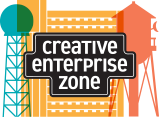
Public Space Work
We work to improve public health, beauty, safety and the environment of the Zone
Goals for public space include:
Creativity
Collaboration with volunteers and key partners in other residential and civic organizations to influence how development and investment creates our shared future.
Ecology
Softening the Zone’s edges with greenery to improve air quality, water quality, and habitat, and better shape our built environment spaces with our community’s values.
Transportation
Strengthening opportunities for people working, living, and visiting the Zone to get to where they want to go without a car.
100 Trees Initiative
Join our grassroots effort to expand the urban tree canopy of the Zone’s industrial South Saint Anthony Park area by growing and planting 100 new street trees each year.
Unified Design Standards
Adopted by three districts along University Ave, the Saint Anthony Park Unified Project Design Standards provide planning and design guidance for development and redevelopment in the Zone.
Chroma Zone
Discover the power of public art to connect, promote, and build community during the CEZ’s annual Chroma Zone Mural & Art Festival in the Zone.
FAQs
-
Most of our area was built for industrial land uses and transportation (like trucking and railroads) and not designed at a human scale.
Most existing public space is public right-of-way, and our streets are impervious hardscape with few sidewalks.
Many existing buildings were designed for industrial function and shipping access, and for a walkable residential neighborhood .
While many existing and future buildings can sustain creative industries, the neighborhood lacks improved public spaces for creative exchange, prosperity, and a sense of belonging.
-
While the Green Line LRT runs straight through the Zone, most of the area is only conveniently accessed by car.
Transit and bike facilities are lacking throughout the neighborhood.
With massive, grade-separated highways and railroads on three sides, access to surrounding neighborhoods and destinations is constrained.
-
With noted exceptions (existing parks and Community Garden), very little spaces serves any significant ecological function.
The lack of trees and plants degrades air quality, raises the ambient temperature, reduces shade, and diminishes enjoyment of public spaces..
The impervious surfaces and lack of natural assets contributes to the urban heat island effect and worsens water and air quality beyond the Zone’s borders.
-
By identifying key challenges and opportunities, the CEZ Public Space Committee advances projects and initiatives (with key community partners) that improve public health, beauty, safety, walkability and well-being through improvements to the built and natural environment, and leads a neighborhood-wide conversation about the environment and public spaces.
Interested in getting involved? Contact Committee Chair Ben Shardlow at info@creativeenterprisezone.org
Related Stories













